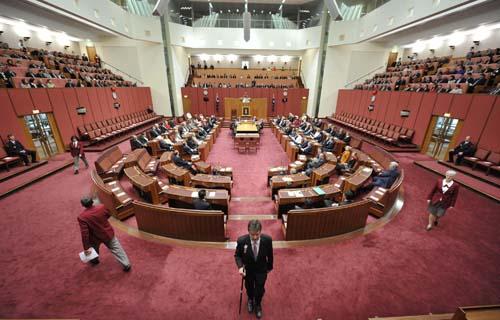
The Australian Senate has released in interim report based on findings at hearings held this year.
As part of the introduction, the interim report states:
Why are there so many people who live in close proximity to wind turbines complaining of similar physiological and psychological symptoms? As with previous Senate inquiries, this committee has gathered evidence from many submitters attributing symptoms of dizziness, nausea, migraines, high blood pressure, tinnitus, chronic sleep deprivation and depression to the operation of nearby wind turbines. The committee invites the public to read and consider the evidence of people who have experienced these symptoms and who attribute their anxiety and ill health to the operation of turbines.[2]
1.13 These health affects should not be trivialised or ignored. The committee was particularly distressed by renewable energy advocates, wind farm developers and operators, public officials and academics who publicly derided and sometimes lampooned local residents who were genuinely attempting to make known the adverse health effects they were suffering.
1.14 The committee is aware of people complaining of these impacts who have since left their family home. Some now live a nomadic and uncertain existence. In one case, the now deserted home had been in the family for five generations—since the 1840s. These are not decisions taken lightly. Having left the turbine vicinity, several witnesses noted that the symptoms had faded if not disappeared.[3]
Excerpt:
Interim report
1.1 The Senate Select Committee on Wind Turbines was established in December 2014. To date, it has received 464 submissions from a wide range of stakeholders. It has conducted public hearings in Portland in south-west Victoria on 30 March, in Cairns on 18 May, in Canberra on 19 May, in Melbourne on 9 June and in Adelaide on 10 June 2015. Further public hearings are planned in Canberra on 19 June and 23 June and in Sydney on 29 June 2015.
1.2 This represents a considerable volume of evidence relating directly to the committee’s terms of reference. The committee has received written and verbal evidence from State Governments, local councils, various federal government agencies, wind farm operators and manufacturers, country fire authorities, acousticians, medical experts and representatives from various associations and institutes. In addition, many private citizens have had the opportunity to voice their concerns with the planning, consultation, approval, development and operation of wind farms in Australia.
1.3 Access to all public submissions and public hearing transcripts can be found on the committee’s website.[1]
The committee’s headline recommendations
1.4 This report presents seven headline recommendations. The committee believes that these recommendations are important and urgent given that legislation on the renewable energy target is due to be debated in the Senate shortly. The final report in August this year will provide supporting evidence and supporting recommendations. It will also address other terms of reference, including the merit of subsidies for wind farm operators and the effect of wind power on household power prices.
Find the recommendations here.



1 Comments